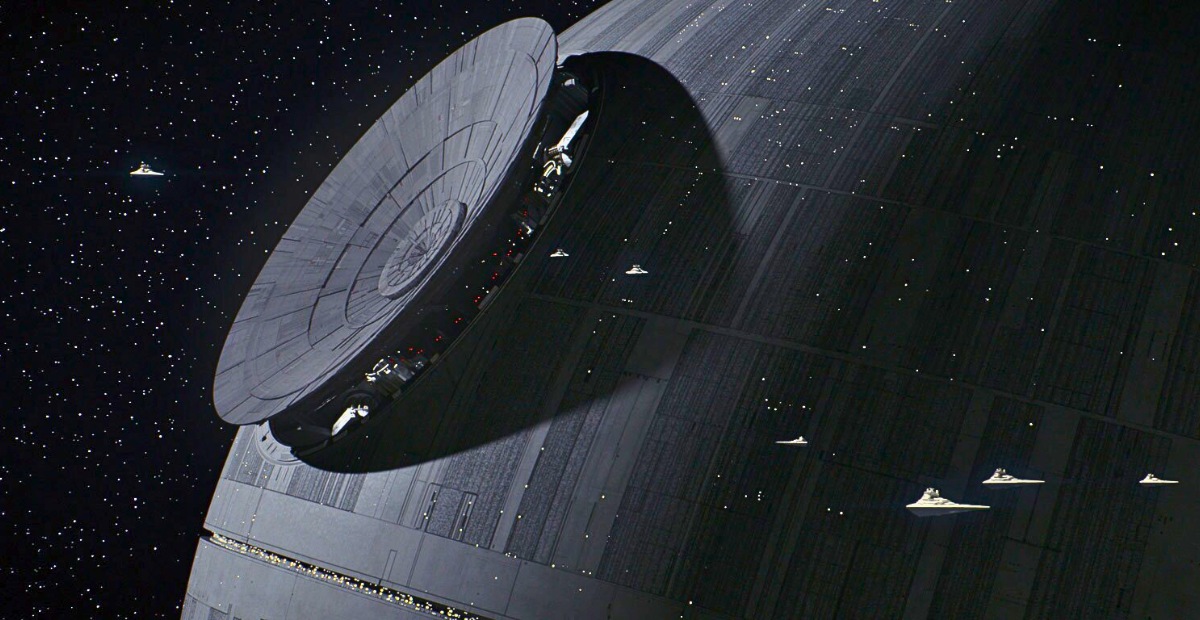The Death Star stands as the ultimate symbol of the Empire’s power. A battle station capable of erasing entire planets in one strike. Since nuclear weapons and orbital bombardments existed in the galaxy, it’s fair to ask why the Empire didn’t rely on them instead. The answer lies in fear, efficiency, and control.
Fear as a Weapon: The Tarkin Doctrine
Grand Moff Tarkin’s Doctrine of Fear argued that terror was more effective than continuous military campaigns. The Death Star was the ultimate expression of that philosophy. Its sheer size made it a visible threat, and its superlaser offered an instant, irreversible outcome. When Alderaan was destroyed, the goal was not only to eliminate one planet but to send a warning to every system in the galaxy: disobedience would lead to total erasure.
This certainty was what set the Death Star apart from other weapons. Unlike fleets or nukes that left survivors, fallout, or the need for extended sieges, the Death Star erased resistance in a single strike. The Emperor and Tarkin didn’t need it to fire often; just a few public demonstrations were enough to enforce compliance across thousands of worlds. Its existence alone reduced the need for long wars and endless deployments, making fear the most efficient weapon in the Empire’s arsenal.
Limits of Nukes and Orbital Bombardment
Imperial fleets already had the ability to devastate worlds. The “Base Delta Zero” command authorized Star Destroyers to reduce planets to molten wastelands through sustained bombardment. This was effective but required coordination of multiple ships and time to complete the task.
The order Base Delta Zero first appeared in Legends material but has since entered official canon. In recent shows like Star Wars Rebels and The Bad Batch, the phrase describes total planetary destruction by Imperial fleets, proving that some of the galaxy’s most devastating ideas didn’t stay confined to Legends for long.
Nuclear strikes carried their own complications. They could level cities, contaminate ecosystems, and leave long-term fallout. Survivors could regroup, resist, or escape before total destruction was complete. Neither nukes nor conventional bombardments could erase an entire planet in a single instant. The Death Star’s superlaser offered a level of finality no other weapon matched.
Within the story, the Death Star served as the galaxy’s ultimate deterrent. Outside the story, it works as Star Wars’ allegory for nuclear weapons. On Earth, nuclear arms reshaped geopolitics because all human activity was confined to one planet. Deterrence worked because there was no escape from the consequences of nuclear war.
The Star Wars galaxy is very different. Countless species live across thousands of star systems, and hyperspace travel makes relocation possible. A nuclear strike might devastate a city or region, but survivors could flee to another world and rebuild. That kind of weapon could not guarantee control over an entire galaxy. A moon-sized station capable of destroying planets outright solved this problem. It communicated Imperial dominance with clarity and scale that ordinary nukes could never match.
Fun Fact: The Empire Did Use Nuclear-Type Weapons
The Empire did not entirely ignore nuclear-scale arms. During the Purge of Mandalore, Imperial bombers released weapons that created mushroom clouds and left the planet’s surface irradiated and uninhabitable.
These strikes wiped out Mandalorian resistance, showing that nuclear effects were part of the Imperial arsenal. Still, these weapons were tactical choices. They lacked the broad, galaxy-wide impact the Emperor demanded for his grand strategy.

